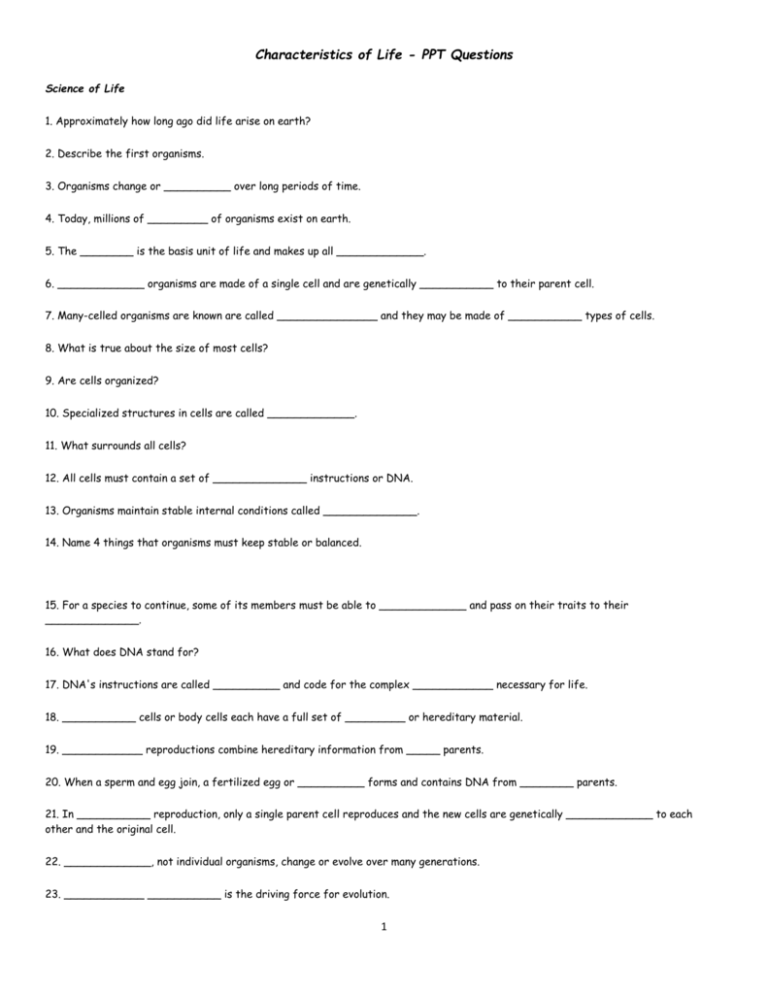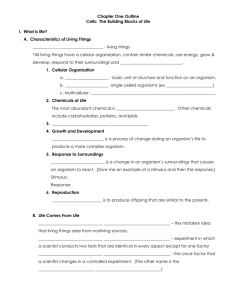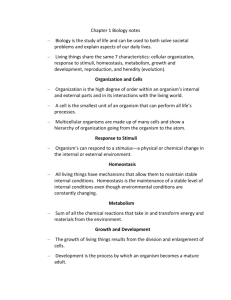Click HERE for Notebook Copy
advertisement

Characteristics of Life - PPT Questions Science of Life 1. Approximately how long ago did life arise on earth? 2. Describe the first organisms. 3. Organisms change or __________ over long periods of time. 4. Today, millions of _________ of organisms exist on earth. 5. The ________ is the basis unit of life and makes up all _____________. 6. _____________ organisms are made of a single cell and are genetically ___________ to their parent cell. 7. Many-celled organisms are known are called _______________ and they may be made of ___________ types of cells. 8. What is true about the size of most cells? 9. Are cells organized? 10. Specialized structures in cells are called _____________. 11. What surrounds all cells? 12. All cells must contain a set of ______________ instructions or DNA. 13. Organisms maintain stable internal conditions called ______________. 14. Name 4 things that organisms must keep stable or balanced. 15. For a species to continue, some of its members must be able to _____________ and pass on their traits to their ______________. 16. What does DNA stand for? 17. DNA's instructions are called __________ and code for the complex ____________ necessary for life. 18. ___________ cells or body cells each have a full set of _________ or hereditary material. 19. ____________ reproductions combine hereditary information from _____ parents. 20. When a sperm and egg join, a fertilized egg or __________ forms and contains DNA from ________ parents. 21. In ___________ reproduction, only a single parent cell reproduces and the new cells are genetically _____________ to each other and the original cell. 22. _____________, not individual organisms, change or evolve over many generations. 23. ____________ ___________ is the driving force for evolution. 1 24. According to natural selection, which individuals in a population are more likely to survive and be able to reproduce? 25. A change in population due to the survival & reproduction of organisms with favorable traits is known as what? 26. Define ecology. 27. Name 3 things that organisms need from their environment. Matter, Energy, & Organization 28. Organisms require a constant supply of ____________. 29. The _________ directly or indirectly supplies the energy for living things. 30. ______________ is the process of capturing sunlight and changing it into stored ____________ energy for organisms. 31. __________ are organisms that can make their own food. 32. _____________ use _________ for photosynthesis converting _________ and _______ into sugar and __________. 33. ______________ use chemicals to get energy. 34. Organisms that can't make their own food are known as _____________ and may be __________ eating autotrophs, ______________ eating other heterotrophs, or ______________eating both autotrophs and heterotrophs to get energy. World of Biology 35. The size of organisms depends on the ___________ of cells that make it up and not the _______ of the cells. 36. Organelles are cell structures that carry out different ___________ for the cell. 37. The sum of all the chemical processes in organisms is called _____________. 38. _________ is needed for all metabolic processes including growth and reproduction. 39. Homeostasis is when an n organism maintains ____________ internal conditions such as body temperature. 40. Name 2 processes that result in the growth of an organism. 41. All new cells develop from ______________ cells. 42. New cells ___________ as they mature. 43. The process of an organism become an adult is called ______________ and involves numerous cell ____________ and cell _______________. 44. Do all members of a species have to be able to reproduce for the species to continue? 45. Organisms respond to ____________ from their environment such as light, __________, heat, and touch. 2 Scientific Method 46. The scientific method begins with _____________ that involves using your senses to perceive objects or events in the natural world. 47. Based on their observations and questioning, scientists make a ________________ that can tested through experimentation. 48. Hypothesis may have to be ___________ after an experiment is done if it is NOT supported by the data. 49. Testing a hypothesis must be done in a ______________ experiment that includes a control group that can be compared to a ______________ group. 50. How many factors may be different between the control group & experimental group? 51. What is this one factor called? 52. The ___________ variable is measured in both groups. 53. Information collected in an experiment is called ___________. 54. When numerical data is collected, it is called _____________ data. 55. _____________ may be used when the population size is too large for the experiment. 56. Collected data must be organized into ___________, ____________, or graphs. 57. A ___________ may be formed from many related hypotheses that have been tested & support the evidence. 58. When scientists complete their experiments they must _________ their work with other scientists. 59. Scientific work may be printed in scientific ____________ or presented as papers as scientific ______________. Microscopes 60. Microscopes produce an enlarged ____________ of an object due to ____________ of the microscope lenses. 61. The clearness of a microscope image is known as ____________. 62. Arrange these things in order from smallest to largest - fly, animal cell, atom, virus, organelle, bacterial cell. 63. Label the parts of this microscope. 3 64. Where is the specimen placed in order to view it through a microscope? 65. What lens do you look through at the top of a microscope and what is its magnification? 66. What are the lenses called on the revolving nosepiece? 67. How do you determine the total magnification for a microscope? 68. Which knob should be turned to focus on low power? 69. Which knob should be turned to focus on high power? 70. How should a microscope be carried? 71. What should be done when you are finished using a microscope? 72. The best light microscopes can magnify images up to how many times? 73. What type of microscope can used to view inside of cells that have been thinly sliced? 74. What is total magnification for the TEM? 75. What type of microscope produces a 3-D image of the surface of an object? 76. Can electron microscopes be used to view living specimens? Measurements 77. Scientists use the _____________ system or _______. 78. The SI system is based on units of _______. 79.The basic metric unit of measure is __________ for mass, _________ for volume, __________ for temperature, _____________ for length, and __________ for time. 80. What are the most common prefixes used for biology and what do they stand for? 4






